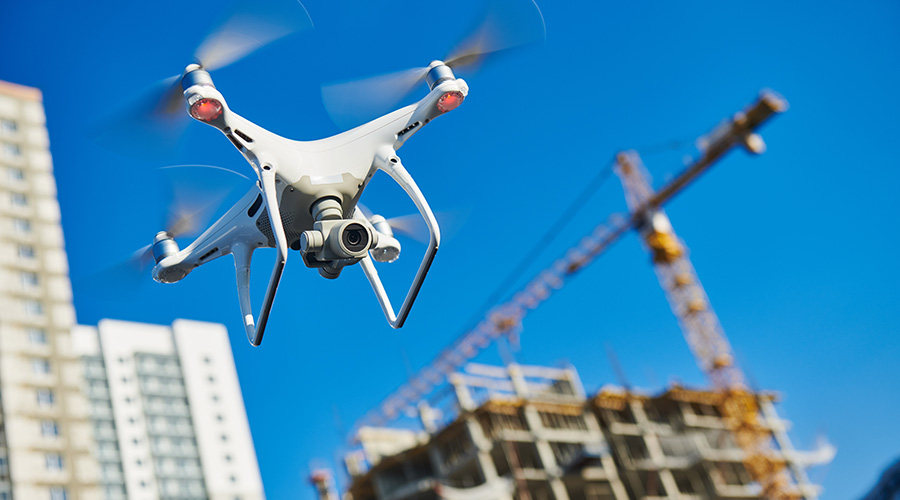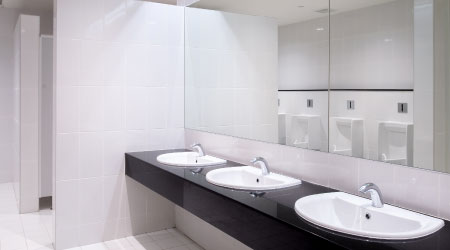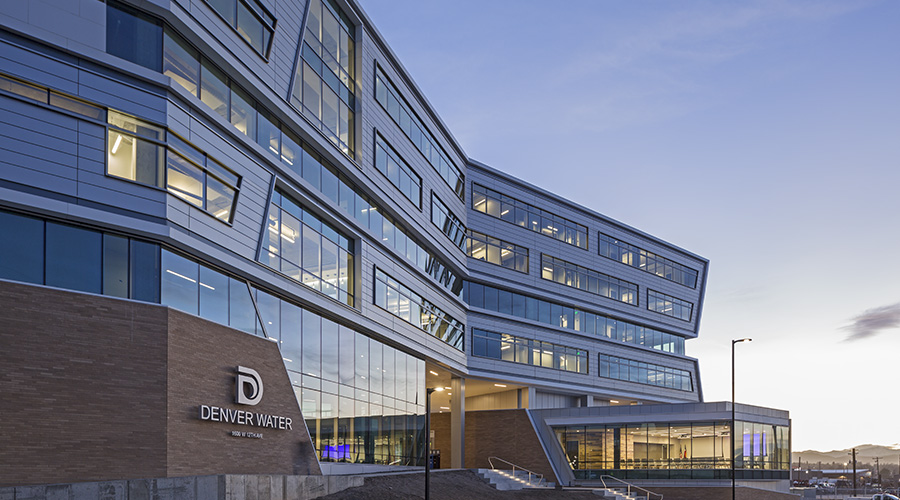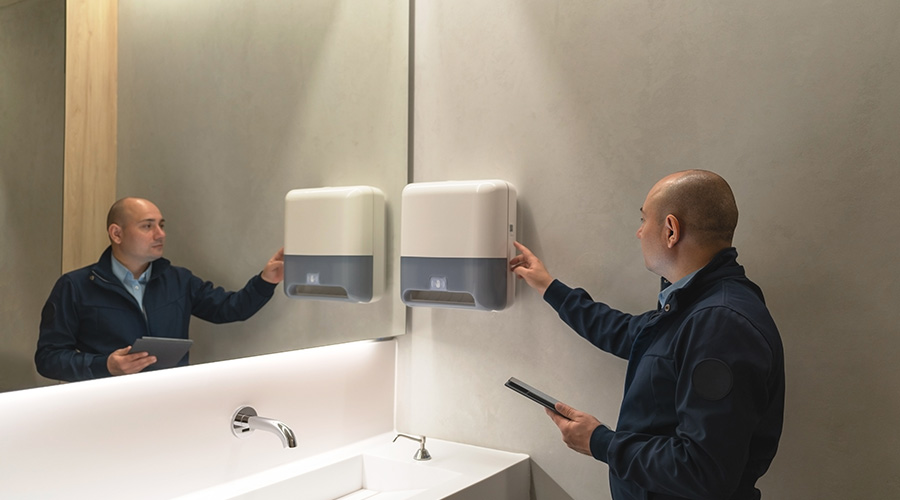Plumbing Systems: Waste Not, Pay Not
New technology can cut water waste in facilities, but finding and repairing leaks in plumbing systems can be more cost-effective
New-generation plumbing equipment can help organizations conserve water, but the up-front costs can be steep. A more cost-effective option for many organizations is greater efficiency through preventive maintenance (PM) of these systems and their components.
By understanding the most common sources of water waste in plumbing systems and by implementing a comprehensive program of testing and repairs, managers can help their organizations clamp down on water waste and control costs.
Finding the Waste
Managers are very familiar with most common sources of water waste — high-flow fixtures, aging fixtures, leaks, neglect, and careless or unattended use. Public utilities and private wells process billions of gallons of water a day, but nearly 15 percent of this water is wasted, inflating many organizations’ water and sewer bills and overloading utility capacity.
Restroom toilets, urinals, lavatories and showers use a great deal of water daily. Many facilities still feature older fixtures that use twice as much water as newer designs that have been introduced since the early 1990s. Also, high-use fixtures might be worn out from normal cycling wear, so they tend to leak when shut off. Associated piping also might have developed leaks, often hidden behind wall panels or underground and undetected.
Finally, housekeeping crews use large amounts of water each day when cleaning and sanitizing restroom fixtures; cleaning floors, walls, stall partitions, mirrors and windows; and flushing slow or plugged drains.
All of these areas are potential sources of waste if not taken care of promptly, and managers have a number of options to address them cost-effectively.
A comprehensive testing and repair process can eliminate waste, as well as increase occupant satisfaction. The process has four key components: the right job done right; calculated frequency; comprehensive attention to all fixtures, piping, pumps, valves and fittings; and regular, phased upgrades to introduce new, more productive and economical technology to facilities.
The Right Job Done Right
Many plumbing components are hidden, so managers first must find out where to devote money and time for the best return.
This phase begins with a good PM program based on daily inspections. For these inspections, technicians can organize all of the restrooms and plumbing systems into a route or routes to minimize travel time. They also can perform visual inspections to check conditions and catch problems before they become emergencies. A slow drain or a small drip is easier to deal with than a complete stoppage or a major leak, and it is less costly in terms of labor, material and waste.
Diagnostic tests done every three months also play an important role in the inspection process. For example, technicians can inspect interior pipeline conditions using a borescope, closed circuit television (CCTV) or imaging technology. Two new options available to managers and technicians are laser technology and improved imaging systems with high-resolution pictures and reference scales that measure a defect accurately.
Calculating Repair Frequency
A complete historical record showing replacement of system components frequencies enables maintenance managers to anticipate the remaining performance life of plumbing fixtures and replace them at the optimum time. By examining the time between repairs or replacements, managers can anticipate the next repair from the same or similar components. For example, since many municipalities now soften their water at the utility, managers might consider discontinuing their use of their softening systems, or at least decreasing frequency of regeneration to save salt and water.
Providing Full Coverage
With new equipment, expanded facilities and upgrades coming on line regularly, it is essential that managers adjust plumbing inspection and repair programs and schedules to accommodate these changes. As a rule of thumb, every time a new equipment record is created, the inspector or planner should perform a pre-inspection.
Included in this pre-inspection is a review of the equipment’s operation and maintenance manuals to obtain the manufacturer’s recommended PM tasks and frequencies. The planner enters the tasks in the maintenance management software’s PM schedule right away, along with a start date and frequency, to ensure that the coverage begins in a timely manner.
Incorporating New Technology
System upgrades that are phased in when old fixtures wear out have a definite place in a comprehensive plumbing maintenance strategy. This approach spreads out the cost of upgrades and reduces the investment to the difference between the cost of replacing the old component with the same technology and with the new technology.
One example of the benefits involves installing new automatic flush handles to replace manual handles. One model of an automatic handle is battery-operated and touchless, and it saves water and meets accessibility requirements. The valve actuator is a continuous infrared beam, which triggers a flush after the user leaves the area.
This upgrade installs in three easy steps without turning off the water: Remove the manual handle by unscrewing the collar nut with the wrench provided in the upgrade kit. Insert the included collar gasket into the collar nut. Install the flush control unit into the valve where the handle was. Using this method, the handle is retained for use when servicing the automatic control, or it can be swapped for a spare automatic control.
Technicians then activate the unit by loosening one screw with the allen wrench to remove the slide-out battery tray, inserting the four C batteries, replacing the tray, and replacing the screw. The last three screw turns activate the unit in automatic flush handle mode. An object-lock adjustment sets the infrared beam distance so momentary interruptions or the movement of nearby objects do not affect it.
One objection to plumbing system upgrades used to be that they didn’t cover the range of applications needed. This upgrade answers that need, and it can save water because the urinal valve has four different use-oriented frequency settings: normal, which flushes at every use; water saver, which flushes every other use; sanitary, which flushes before and after each use; and stadium, which flushes every three minutes during continuous use.
A strategy of gradual replacement as part of PM schedule can also apply to water-saving toilets, waterless urinals, touchless faucets, water-saving shower heads, and faucet and shower head aerators that further reduce water use without a large, one-time budget hit.New-generation maintenance
Managers have been living with continuous building construction for years. The larger a campus gets, the larger the maintenance workload becomes, and the more difficult it is to keep all systems going. But a closer look at the PM program as new construction and upgrades go on line might reveal hidden opportunities to more efficiently manage the increased workload.
If managers replace PM routines and frequencies designed for old fixtures with more efficient routines and frequencies appropriate for the new upgrades, the result might be significant value-added maintenance and many potential savings, while still meeting expanded schedules with existing staffing.
Take the automatic flush handle example above. The new components have different but very simple maintenance requirements, due to the built-in predictive maintenance and troubleshooting functions. A separate LED and an audible tone both indicate when it is time to change the batteries, which is very seldom, often only once a year.
If the separate object-lock sensor light flashes when no user present, the solution is to remove any object covering the sensor or reset it by adjusting a set screw on the unit. If the valve doesn’t flush, reset the sensor or replace weak batteries. If the valve continues to run after flushing, either a blockage is preventing the diaphragm from closing or the valve control stop needs adjusting. These conditions remain the same, since they are part of the old valve. The new maintenance plan must reflect the new routines where needed, while retaining the old routines where possible.
Similar upgrades from leaky manual water faucets, touchless faucets, showers and waterless urinals can deliver additional savings. Other savings, such as using foam instead of liquid soap in properly metered dispensers, can add to the gains. Eliminating soap buildup reduces frequency of chemical or mechanical pipe cleaning and less flushing of pipelines saves water.
Related Topics:











